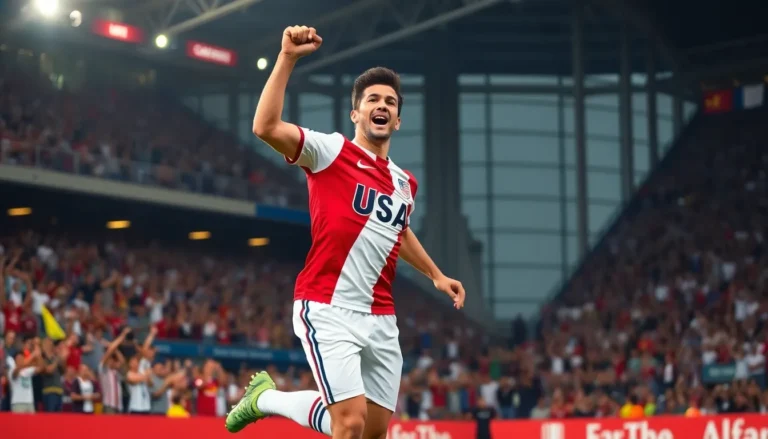Table of Contents
ToggleIn the realm of storytelling, few arcs are as captivating as the reluctant hero. Picture this: a seemingly ordinary individual, perhaps a grumpy barista or an underachieving accountant, suddenly thrust into a world of chaos and adventure. They’d rather binge-watch their favorite series than save the day, yet fate has other plans. This quirky twist on heroism not only keeps audiences on the edge of their seats but also brings a refreshing dose of humor to the narrative.
As they stumble through battles and moral dilemmas, these heroes remind us that bravery doesn’t always come wrapped in a shiny cape. Instead, it often wears sweatpants and a skeptical expression. Join the journey as we explore the reluctant hero arc, where everyday people become extraordinary, one awkward step at a time. Who knew saving the world could be this entertaining?
Understanding the Reluctant Hero Arc
The reluctant hero represents an intriguing character type in storytelling. While they often display hesitance toward their heroic fate, these characters reveal their strengths as they navigate complex situations.
Definition of the Reluctant Hero
A reluctant hero typically resists their call to adventure. Instead of seeking out glory, they often find themselves compelled to act when circumstances demand it. These heroes showcase qualities that resonate with ordinary individuals, as they embody the struggle between personal desires and the call to duty. This tension creates a dynamic narrative that captivates audiences.
Characteristics of a Reluctant Hero
Reluctant heroes share several defining traits. They often exhibit a desire for normalcy, preferring routine over adventure. Humor provides comic relief to their serious circumstances, enhancing relatability. Moral dilemmas frequently challenge their decisions, highlighting internal conflict. An underlying growth potential exists, showcasing their transformation from ordinary to extraordinary. Readers connect with these heroes as they confront fears, ultimately accepting their roles in crucial moments.
Popular Examples of the Reluctant Hero Arc

Reluctant heroes appear across various storytelling mediums, showcasing their unique journeys. Some prominent examples stand out due to their compelling narratives.
Classic Literature
In classic literature, characters such as Frodo Baggins from J.R.R. Tolkien’s The Lord of the Rings exemplify the reluctant hero arc. Frodo, an ordinary hobbit, wishes to live a simple life in the Shire. Unwillingly thrust into an epic quest, he struggles with his fears and responsibilities. Charles Dickens’ Ebenezer Scrooge also fits this mold. Initially resistant to change, Scrooge transforms through the guidance of supernatural beings. These characters embody the tension between their desires for normalcy and the call to heroic action.
Modern Films and TV Shows
Modern films and television series feature several reluctant heroes that resonate with audiences. In The Matrix, Neo represents a reluctant hero who grapples with his extraordinary destiny. Initially, he seeks comfort in his mundane life as a hacker. In Spider-Man, Peter Parker showcases similar resistance; he yearns for a normal existence but ultimately embraces his role as a hero. Both characters illustrate internal conflicts, balancing personal desires against their responsibilities to protect others.
The Psychological Impact of the Reluctant Hero Arc
The reluctant hero arc evokes deep psychological themes, enriching narratives with their internal struggles.
Internal Conflicts and Growth
Characters in this trope face significant internal conflicts. They often grapple with fear, self-doubt, and the tension between personal desires and societal expectations. Over time, reluctant heroes often undergo profound growth, moving from a place of reluctance to one of acceptance. A pivotal moment, like realizing the stakes of their inaction, prompts them to embrace their roles. This transformation captivates audiences, as they witness the hero’s journey from mundane to extraordinary. Frodo Baggins illustrates this well; he evolves from a simple hobbit into a courageous figure willing to tackle immense challenges.
Audience Relatability
Reluctant heroes resonate with audiences due to their relatable vulnerabilities. Many people experience moments of self-doubt and hesitation, making these characters easily understandable. They reflect the struggle of balancing personal aspirations with unforeseen responsibilities. As they blend humor and humility, readers and viewers find comfort in their flaws. For instance, Peter Parker embodies the tension between wanting a normal life and needing to fulfill the greater good. This duality humanizes him, forging a connection with those who also desire to escape life’s pressures while handling their obligations.
Writing Techniques for Crafting a Reluctant Hero Arc
Creating a compelling reluctant hero arc involves several key techniques that deepen character development and enhance narrative tension.
Developing Complex Characters
Crafting a reluctant hero begins with building complex characters. Delve into their backgrounds to reveal motivations and fears. For instance, showing a character’s mundane life highlights their desire for normalcy. Introducing flaws humanizes them, making audiences relate to their struggles. Incorporate internal dialogue to illustrate conflicts between personal desires and heroic duties. Characters like Frodo Baggins demonstrate this complexity through their reluctance and growth. They evolve not simply because of external events but also due to internal realizations. Emphasizing these elements draws readers into their journey, enriching the storytelling experience.
Balancing Reluctance and Heroism
Striking a balance between reluctance and heroism creates engaging narrative tension. Place obstacles that challenge the hero’s initial resistance, prompting gradual acceptance of their role. For example, external threats like a villain or catastrophe push the character out of their comfort zone. Continually intertwining moments of humor with intense situations helps maintain relatability. Gradually increasing stakes showcases the hero’s transformation as they confront fears. Characters like Neo from The Matrix capture this balance perfectly. Their journey emphasizes that true heroism often emerges from adversity, illustrating how personal challenges forge extraordinary individuals.
The reluctant hero arc remains a powerful narrative device that resonates with audiences across generations. By showcasing the journey of ordinary individuals who rise to extraordinary challenges, stories become rich with humor and relatability. These characters embody the struggle between personal desires and the call to action, making their growth all the more compelling.
Through their internal conflicts and eventual acceptance of their roles, reluctant heroes reflect the complexities of human experience. Their stories remind us that heroism can emerge from the most unexpected places, inspiring readers and viewers to embrace their own potential for greatness, even when faced with uncertainty.







